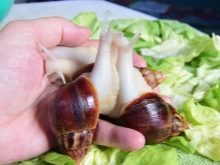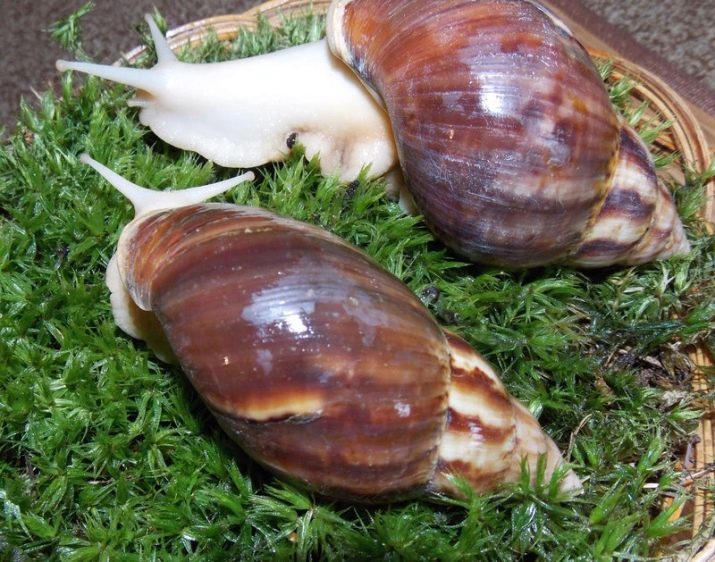Surprisingly, whom only people do not keep in their home instead of pets! Many of us do not have various exotic pets, not because they can bite, but because they are unpleasant to us. Achatina fulika is a pretty attractive creature. Even those who do not like snails may be interested in seeing these specimens. They look bright, unusual and have large sizes. By the way, this attracts attention.

Features
The snails in question are very unusual. They have an exotic look, a lot of rumors go around them. For example, it is generally accepted that in some countries severe penalties are provided for the content of these individuals because they are omnivorous and can destroy almost all crops. It is fair to say that the rumors are not unfounded. Really, in some states, snails are prohibited because they are considered pests.
The usual habitat of mysterious creatures is the coast of North Africa. There is a humid and warm climate. They are found mainly in sown fields, in forests or marshy areas. For their life, a temperature of 20 to 25 degrees is necessary. If it drops to 3 degrees, snails have suspended animation.
As already mentioned, individuals of the fulica species differ from their counterparts in large sizes. Adult snails grow to a length of 35 cm, and their width can range from 12 to 15 cm. Weight is about 600 g, and it can also fluctuate.


These individuals differ in very beautiful and diverse colors. They have a well-developed sense of smell. Their carapace may have a reddish, brown, yellow, or light yellow pattern.The body that is in the shell can be yellowish, dark or light (the shell has mimicry, changes color depending on the color of the environment), and four tentacles must rise on the head. Short ones are the sensory organ, and long ones are the eyes. The mollusk has no hearing, but this defect is well compensated by excellent eyesight and touch.
By the way, with the help of smell, the snail finds food, a partner for mating, and also feels the imminent danger. The height of the conical shell is usually about twice its width, and consists of 9-11 revolutions. Inside the body of the mollusk are the lungs, heart, kidneys, and even there is an embryo of brain tissue. Radula is the teeth of Achatina. They look like a gear band. The snail breathes through the skin. Vision is very good and allows you to view the space at a distance of one centimeter. With the help of vision, light is also recognized.
The mollusk has receptors that are located on the sole. They determine the shape and texture of the coating. If it is not smooth enough, then a special mucous substance, which the snail secretes, helps the movement.


The individuals described by us grow quite quickly. Here is a growth table, according to which everything will be clearly visible.
Achatina Immaculate \ Achatina Panther | 1 month - 2 cm | 2 months - 4 cm | 3 months - 6 cm | 4 months - 10 cm |
Achatina Fulika | 1 month - 2+ cm | 2 months - 4+ cm | 3 months - 6+ cm | 4 months - 10+ cm by year completes growth |
Achatina reticulate | 1 month - 3+ cm | 2 months - 7+ cm | 3 months - 10+ cm | 4 months - 14+ cm by year completes growth |
Archakhatina marginata ovum \ suturalis | 1 month - 2-3 cm | 2 months - 4-5 cm | 3 months - 6-7 cm | 4 months - 8-9 cm 5 months 10+ cm |

Habitat and lifestyle
Every schoolchild knows that all snails live where it is warm and damp. But if we talk about representatives of the Achatina, it can be argued that this species was first discovered in 1930 in China, in the city of sub-provincial significance Xiamen. Then, somehow, this species came to Pratas (Taiwan Island). And with someone's light hand spread to India and the Pacific.
The distribution of this species did not stop there. The snail continued to conquer the islands in the Indian Ocean, even came to the United States. By the way, now there the Achatina is destroyed without any regret. Maybe they would start doing the same with the “aliens” in Europe, but the local climate did not suit them. Distribution has failed, and now in European countries snails are bred just for fun.
If we take into account the fact that Achatina are perceived by people as pets, then we can safely say that they are spread around the world. Russia is no exception.
Here they can not be found on the streets and in the forest, but can be found in laboratories where students study. Also, this type of mollusk coexists perfectly in apartments and houses of people. On sites where all living creatures are offered, exotics lovers sell and buy Achatina.


Large snails are in demand not without reason. They are unpretentious in content and food. Do not make noise and do not require constant attention of the owners. And all because they are nocturnal. In the afternoon, mollusks like to spend time burying themselves in the farthest corner of the aquarium or terrarium. Hiding mainly in the ground. This type of snail has a long-term memory: they remember all the events that occurred within an hour. They can also determine feeding places and places where water is located. This was proved by American scientists.
In the wild, mollusks can travel long distances, and they do it very quickly. Special mobility are young individuals. But the old snails are trying to stay in one constant place, from which they crawl out to eat. The "old men" practically do not leave their nook and do not move away from it by more than 6 meters. But if you take the mollusk about 25 meters from its habitat, it is able to find a way back.
If adverse conditions occur (drought in nature or poor conditions in the aquarium), then Achatina fulica hibernates. It can last six months. Some breeders note that the mollusk may not come out of hibernation.
Therefore, African Achatina must be treated with care. When changing the soil, violation of humidity, temperature or feeding regimen, your pet may react with suspended animation. The snail "seals" itself in a shell with the help of a special secret from calcareous compounds. They will dry and create reliable protection.


Varieties
The variety of species of snails is amazing. Let's try to consider them in more detail.
- The shell of Achatina rhodium can grow more than 20 cm, it has a conical shape. Curls are twisted clockwise and counterclockwise. This is an albino snail (has a completely white body), but the shell casts a yellow color.
- In Bhutan, local stray dogs died, poisoned by Achatina fulica hamillei meat. In addition, the Hemel began to attack farmland. The attitude towards them is negative there.
- Where the temperature is between 25-28 degrees all year round, you can find Achatina fulica umbilicata. In these parts, she lives in forests, in fields with crops, in the territory of wetlands.
- East Africa, Tanzania, Kenya - All these countries are home to Achatina fulica sinistrosa. This mollusk has a brown shell. Lives in temperature conditions, which range from 23 to 28 degrees. But it can withstand a drop in temperature to 2. Such mollusks are famous for large colonies that only one snail can reproduce. They love a climate characterized by humid tropics.
- The mollusk, which has a variety of colors (from dark brown to homogeneous and light brown), is called Achatina fulica (Achatina fulica standard). It has a standard set of qualities that is inherent in all other types. By the way, these individuals are in demand among those who get snails at home as pets.
- A snail having a massive body of white color and the same shell - this is Achatina fulica var - white jade. Loves wet soil very much.



Growing conditions
They are not as complex as they seem. Shellfish can be kept and grown in an ordinary apartment. A plastic container, an aquarium or a terrarium are best suited. The place of detention should have good ventilation. Equip the bottom with quality soil or shavings (coconut, wood). Soil should occupy one third of the aquarium. Subsequently, your pet will be able to bury in it.
Watch the temperature regime (22-26 degrees) and humidity (65-75%). Place a thermometer and a cup of water in the container, and if something went wrong and your pet hibernated, then raise the temperature to the optimal level and spray the snail with warm water every day. Then everything will be fine, and the mollusk will again begin to please you.


Proper feeding
Domestic snails should be fed diversely. Achatines are herbivorous, so in winter they need to grate and give carrots in small quantities, and you can also please your pet with seasonal fruits. Achatina will not refuse from grain mixtures, fish food, you can still treat them to chicken feed. The daily diet should contain protein (18.28%).
In addition to plant foods, a giant mollusk eats sand, chalk, small stones and bones. This is not surprising, because Achatina need a source of calcium in order for their shell to be strong. And if he is missed, then they will begin to gnaw at each other's shells.
Small snails of this species love plants with very soft leaves. Do not worry about their digestion, as the Achatina fulica snail can determine the food that will benefit her. Feed your pet champignons, boiled chicken (1 time per month), give porridge without salt. Sugar, salt, citrus and acidic foods should not be offered categorically.

How to care?
From a small snail, you can easily grow a large one if you provide it with good care. To do this, give your baby porridge with a high calcium content, a mixture of ground seeds and cereals. You can treat Achatina with boiled porridge, which should contain three cereals. Feed newborns to soft food. You need to start doing this on the second or third day. They like lettuce, chalk, eggshells, sepia.
You need to clean the snail's place of residence weekly, with a complete replacement of the substrate. The tank is washed with plain water, soap and cleaning products must not be used. In addition, when eggs appear, they must be removed, otherwise a huge amount of young animals cannot be avoided. Take a snail only with clean hands, washed with running water. Do not grab the sink, it is best to slightly pry the sole of the pet.

Breeding
It is peculiar in snails of this species. This mollusk is a hermaphrodite (it has testicles and ovaries), and its body produces sperm and eggs at the same time. Therefore, the pet is quite capable of reproduction, despite the small population. One snail transmits another gamete.
Reproduction occurs when a certain age is reached, while individuals of the same size mate. It also happens that small Achatina mate with a larger relative. Usually a large specimen plays the role of a female.

Courts continue for half an hour, and gamete transmission occurs within two hours. Both snails behave intriguingly: they caress each other's heads. Sperm, which the snail partner passes to his brother by sight, has been stored in the body of the last almost two years.
After mating, the female lays up to 300 eggs (their viability is 99%). She can do this up to six times a year. After hatching, the mollusk actively grows for six months, and then its growth slows down. In nature, Achatina live for about six years, but ten can live in captivity.

On the content of Achatina Fulik see below.











